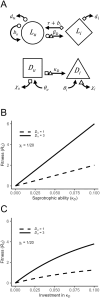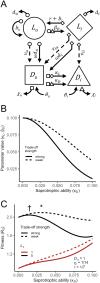Deadly Decomposers: Distinguishing Life History Strategies on the Parasitism-Saprotrophy Spectrum
- PMID: 40528811
- PMCID: PMC12175056
- DOI: 10.1111/ele.70135
Deadly Decomposers: Distinguishing Life History Strategies on the Parasitism-Saprotrophy Spectrum
Abstract
The ability to parasitize living hosts as well as decompose dead organic matter is both common and widespread across prokaryotic and eukaryotic taxa. These parasitic decomposers have long been considered merely accidental or facultative parasites. However, this is often untrue: in many cases, parasitism is integral to the ecology and evolution of these organisms. Combining life cycle information from the literature with a generalised eco-evolutionary model, we define four distinct life history strategies followed by parasitic decomposers. Each strategy has a unique fitness expression, life cycle, ecological context, and set of evolutionary constraints. Correctly classifying parasitic decomposers is essential for understanding their ecology and epidemiology and directly impacts efforts to manage important medical and agricultural pathogens.
Keywords: biotroph‐necrotroph spectrum; entomopathogens; evolution of parasitism; facultative parasites; life history; nosocomial diseases; opportunistic pathogens; sapronosis; trade‐offs.
© 2025 The Author(s). Ecology Letters published by John Wiley & Sons Ltd.
Conflict of interest statement
The authors declare no conflicts of interest.
Figures




Similar articles
-
Assessing the comparative effects of interventions in COPD: a tutorial on network meta-analysis for clinicians.Respir Res. 2024 Dec 21;25(1):438. doi: 10.1186/s12931-024-03056-x. Respir Res. 2024. PMID: 39709425 Free PMC article. Review.
-
Distinct life history strategies underpin clear patterns of succession in microparasite communities infecting a wild mammalian host.Mol Ecol. 2023 Jul;32(13):3733-3746. doi: 10.1111/mec.16949. Epub 2023 Apr 10. Mol Ecol. 2023. PMID: 37009964 Free PMC article.
-
Environmental diversity of Candidatus Babelota and their relationships with protists.mSystems. 2025 Jun 17;10(6):e0026125. doi: 10.1128/msystems.00261-25. Epub 2025 May 28. mSystems. 2025. PMID: 40434078 Free PMC article.
-
Surveillance for Violent Deaths - National Violent Death Reporting System, 50 States, the District of Columbia, and Puerto Rico, 2022.MMWR Surveill Summ. 2025 Jun 12;74(5):1-42. doi: 10.15585/mmwr.ss7405a1. MMWR Surveill Summ. 2025. PMID: 40493548 Free PMC article.
-
A meta-analysis of genome-wide association studies to identify candidate genes associated with feed efficiency traits in pigs.J Anim Sci. 2025 Jan 4;103:skaf010. doi: 10.1093/jas/skaf010. J Anim Sci. 2025. PMID: 39847436 Free PMC article.
References
-
- Abang, M. M. , Baum M., Ceccarelli S., et al. 2006. “Differential Selection on Rhynchosporium Secalis During Parasitic and Saprophytic Phases in the Barley Scald Disease Cycle.” Phytopathology 96: 1214–1222. - PubMed
-
- Akinsanmi, O. A. , Chakraborty S., Backhouse D., and Simpfendorfer S.. 2007. “Passage Through Alternative Hosts Changes the Fitness of Fusarium Graminearum and Fusarium Pseudograminearum.” Environmental Microbiology 9: 512–520. - PubMed
-
- Andersen, S. B. , Gerritsma S., Yusah K. M., et al. 2009. “The Life of a Dead Ant: The Expression of an Adaptive Extended Phenotype.” American Naturalist 174: 424–433. - PubMed
Publication types
MeSH terms
LinkOut - more resources
Full Text Sources

